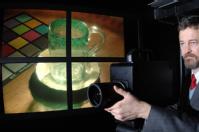WMG News - Latest news from WMG
Surgeons, CCTV & TV football gain from new video technology that banishes shadows and flare
 Researchers at the University of Warwick have developed the world’s first complete High Dynamic Range (HDR) video system, from video capture to image display, that will help a range of users including: surveillance camera operators, surgeons using video to conduct or record surgery, and camera crews following a football being kicked from sunshine into shadow.
Researchers at the University of Warwick have developed the world’s first complete High Dynamic Range (HDR) video system, from video capture to image display, that will help a range of users including: surveillance camera operators, surgeons using video to conduct or record surgery, and camera crews following a football being kicked from sunshine into shadow.
The researchers will be premiering footage of the world's first ever showing of a short film shot using this new HDR technology in the WMG Digital Laboratory at the University of Warwick on Wednesday January 19 at 6:00 PM
Professor Alan Chalmers of WMG’s Visualisation Research group at the University of Warwick will show the footage and talk about the Engineering and Physical Sciences Research Council (EPSRC) project that has helped fund this research. Huw Bowen, of Entanglement Productions, will also discuss the challenges and advantages of making a film in HDR.
Professor Alan Chalmers said:
“We have put together unique compression software with a high performance HDR camera and HDR displays that will revolutionise the use of HDR in a range of applications. The impact will be enormous, for example, the ability to clearly see the football when it is kicked from the shadow of the stadium into sunshine, or surveillance cameras which can detect detail even in extreme lighting conditions.”
“We have also recently successfully trialled its use to assist and document surgery together with the thoracic surgery team and the multi-media group at Heartlands Hospital. HDR is able to accurately capture for the first time the wide range of lighting present in an operation from the dark body cavities through to the bright highlights on the shiny medical instruments.”
“The natural world presents us with a wide range of colours and intensities. In addition, a scene may be constantly changing with, for example, significant differences in lighting levels going from outside to inside or simply as the sun goes behind some clouds, etc. A human eye can cope with those rapid changes and variety but a traditional camera is only capable of capturing a limited range of lighting in any scene. The actual range it can cope with depends on the exposure and f-stop setting of the camera. Anything outside that limited range is either under- or over-exposed.”
“HDR imagery offers a more representative description of real world lighting by storing data with a higher bit-depth per pixel than more conventional images. Although HDR imagery for static images has been around for 15 years, it has not been possible to capture HDR video until now. However such HDR images are typically painstakingly created in computer graphics or generated from a number of static images, often merging only 4 exposures at different stops to build an HDR image”
“Our new HDR camera technology and software enables us to capture and display dynamic HDR images, covering at least 20 f-stops, at full high-definition resolution, and at 30 frames-per-second. Furthermore, HDR can complement 3D technology by providing depth perception without the need to wear 3D glasses.”
Notes for Editors:
As well as seeing the first film recorded with this ground breaking technology there will also be an opportunity to discover more about the unique HDR video camera (capable of 20 f-stops, full HD (1920 × 1080) resolution at 30 frames per second), the HDR displays and the research in HDR being conducted at the University of Warwick.
This project brings together internationally leading expertise in HDR imaging and a unique HDR video technology from the University of Warwick with an innovative professional film maker, Entanglement Productions and a new high-tech company specialising in HDR technology, goHDR - http://www.gohdr.com/
For further information please contact:
Peter Dunn, Head of Communications
University of Warwick +44 (0)24 76 523708
or mobile +44 (0)7767 655860
p.j.dunn@warwick.ac.uk 
Professor Alan Chalmers, WMG
International Digital Laboratory
44 (0)24 765 22102
Alan.Chalmers@warwick.ac.uk
PR5 PJD 7th January 2011
